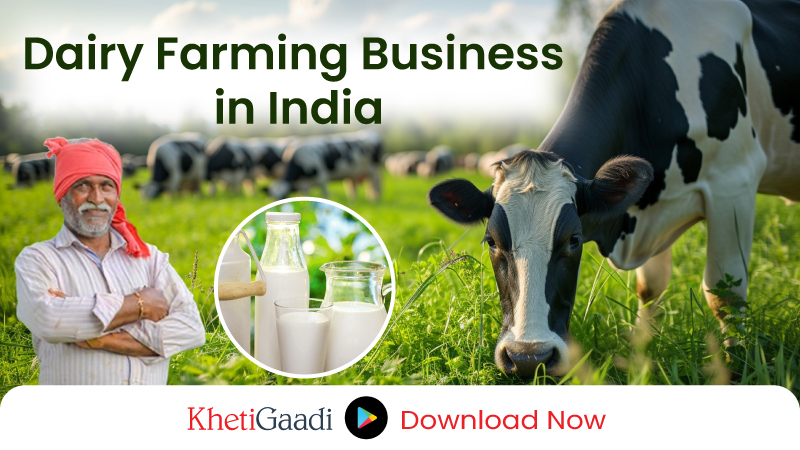Dairy farming is one of the most lucrative and rewarding agricultural ventures in India, with the country being the world’s largest milk producer. With increasing demand for milk and dairy products, starting a dairy farming business presents an excellent opportunity for entrepreneurs to generate sustainable income while contributing to the nation’s food security. However, establishing a successful dairy farm requires careful planning, understanding of market dynamics, and sound management practices. This guide will walk you through the essential steps to start a successful dairy farming business in India.
Dairy Industry at a glance!
| Aspect | Details |
| Industry Overview | Major contributor to the Indian economy; largest milk producer in the world. |
| Major Milk-Producing States | Uttar Pradesh, Madhya Pradesh, Rajasthan, Gujarat, Punjab, Haryana. |
| Types of Dairy Farming | Small-scale (family-owned), Medium-scale, Large-scale commercial operations. |
| Key Dairy Breeds | Indigenous: Gir, Sahiwal, Red Sindhi; Exotic: Holstein Friesian, Jersey, Ayrshire. |
| Milk Production | Approx. 200 million tonnes annually (as of 2024). |
| Per Capita Milk Consumption | ~400 liters/year (varies by region). |
| Key Challenges | Disease management, feed quality, market price fluctuations, infrastructure issues. |
| Government Schemes | National Dairy Plan (NDP), Operation Flood, Dairy Processing and Infrastructure Development Fund (DIDF). |
| Export Markets | Limited; mainly to Southeast Asia, Middle East, Africa. |
| Future Trends | Increasing urban demand, focus on improving breed genetics, dairy technology adoption. |
Market Overview
India’s dairy sector is characterized by its diversity and resilience, comprising both organized and unorganized sectors. The organized sector includes cooperatives and private dairies, while the unorganized sector consists of small farmers and local vendors. According to the National Dairy Development Board (NDDB), India’s dairy industry is expected to grow at a CAGR of 14% between 2020 and 2025, driven by rising incomes, urbanization, and changing dietary preferences.
Key Market Drivers
- Growing Population: With a population exceeding 1.4 billion, India has a large consumer base for milk and dairy products. Milk is an essential part of the Indian diet, used in beverages, cooking, and as a standalone drink.
- Rising Per Capita Consumption: The per capita consumption of milk and dairy products is increasing due to a shift towards healthier and protein-rich diets.
- Expanding Product Portfolio: The demand for value-added dairy products such as cheese, yogurt, butter, and flavoured milk is on the rise, offering additional revenue streams for dairy farmers.
Challenges
- Price Volatility: Fluctuations in milk prices due to supply-demand imbalances and input costs can affect profitability.
- Supply Chain Issues: Inefficient supply chain and distribution networks can lead to milk spoilage and loss of revenue.
- Quality Control: Ensuring the quality and safety of milk products is essential for gaining consumer trust and meeting regulatory standards.
Different Dairy Cattle Breeds Suitable for Indian Conditions
Choosing the right breed of dairy cattle is critical to the success of a dairy farm, as it directly impacts milk yield, adaptability, and disease resistance.
Indigenous Breeds
- Gir: Known for its high milk yield and adaptability to Indian climatic conditions, the Gir breed is popular among dairy farmers. It produces an average of 12-15 liters of milk per day and is known for its disease resistance.
- Sahiwal: The Sahiwal breed is highly regarded for its milk production capacity, averaging 8-10 liters per day. It is also resistant to heat and diseases, making it suitable for Indian conditions.
- Red Sindhi: Known for its hardiness and adaptability, the Red Sindhi breed produces 8-10 liters of milk per day and is well-suited for small-scale dairy farming.
Crossbreeds
- Jersey Cross: The Jersey crossbreed is known for its high milk yield and better fat content. It produces 15-20 liters of milk per day and adapts well to Indian climatic conditions.
- Holstein Friesian Cross: This breed is preferred for its superior milk yield, producing 20-25 liters per day. However, it requires better management and care due to its susceptibility to diseases.
Exotic Breeds
- Holstein Friesian: Known for its high milk production, this breed can yield up to 25-30 liters of milk per day. However, it requires specialized care, feeding, and management.
- Jersey: The Jersey breed is known for its rich milk with high butterfat content, producing 15-20 liters per day. It is more adaptable to Indian conditions compared to Holstein Friesian.
Selecting an Appropriate Location for a Dairy Farm
Choosing the right location for your dairy farm is crucial for its success and profitability. The location impacts various aspects of the business, including logistics, access to resources, and market reach.
Key Considerations
- Proximity to Markets: A location close to urban centers ensures easy access to markets, reducing transportation costs and spoilage risks. It also enables quick delivery of fresh milk to consumers.
- Availability of Resources: Ensure the availability of essential resources such as water, fodder, and veterinary services. A location with abundant water supply and grazing land reduces feed costs and supports sustainable farming practices.
- Infrastructure: Choose a location with good road connectivity and infrastructure facilities such as electricity, cold storage, and processing units. Efficient infrastructure facilitates smooth operations and reduces operational costs.
- Climate Conditions: Consider the climate and weather conditions of the location, as they can affect cattle health and productivity. Areas with moderate temperatures are more suitable for dairy farming.
- Biosecurity Measures: Select a location that minimizes the risk of disease outbreaks and allows for effective biosecurity measures to protect livestock health.
Disease Prevention in Dairy Farming
Disease prevention is vital for maintaining the health and productivity of dairy cattle, ensuring the quality and safety of milk, and reducing economic losses.
Common Dairy Cattle Diseases
- Mastitis: A bacterial infection of the udder, mastitis is a common disease that affects milk yield and quality.
- Foot and Mouth Disease (FMD): A highly contagious viral disease, FMD affects cattle health and can lead to significant economic losses.
- Brucellosis: This bacterial infection affects reproductive health and can result in reduced fertility and milk production.
- Tuberculosis: A chronic bacterial infection, tuberculosis poses health risks to both cattle and humans.
Disease Prevention Measures
- Vaccination: Implement a regular vaccination program to protect cattle from common diseases and outbreaks.
- Biosecurity: Implement strict biosecurity measures to prevent the entry and spread of diseases on the farm. This includes quarantine protocols for new animals and controlling access to the farm.
- Hygiene Practices: Maintain clean and hygienic conditions in cattle sheds, milking areas, and storage facilities to reduce the risk of infections.
- Regular Health Checks: Conduct regular health checks and screenings for early detection and treatment of diseases.
- Nutrition: Provide a balanced and nutritious diet to boost cattle immunity and overall health.
Regulatory Aspects of Dairy Farming in India
Understanding the regulatory landscape is essential for establishing and running a dairy farm in India. Compliance with legal requirements ensures smooth operations and avoids legal issues.
Necessary Permits and Licenses
- FSSAI Registration: Dairy farmers must obtain a license or registration from the Food Safety and Standards Authority of India (FSSAI) to ensure compliance with food safety standards.
- Animal Husbandry Department Registration: Register the farm with the local Animal Husbandry Department to access government schemes and support.
- Pollution Control Board Clearance: Obtain clearance from the State Pollution Control Board to ensure compliance with environmental regulations.
- Municipal Licenses: Acquire necessary municipal licenses for waste management and disposal.
- VAT/GST Registration: Register for Value Added Tax (VAT) or Goods and Services Tax (GST) if you plan to sell processed dairy products.
Compliance Requirements
- Animal Welfare: Ensure compliance with animal welfare regulations, including humane treatment and proper housing of cattle.
- Milk Quality Standards: Adhere to quality standards for milk production, storage, and transportation as specified by regulatory authorities.
- Environmental Regulations: Implement environmentally sustainable practices and waste management systems to minimize environmental impact.
Starting and Running a Dairy Farm
Starting a dairy farm requires careful financial planning to ensure profitability and sustainability.
Initial Investment
- Land and Infrastructure: Invest in suitable land and build infrastructure such as cattle sheds, milking parlors, storage facilities, and water supply systems.
- Cattle Purchase: Purchase high-quality dairy cattle with good genetics and health records. The cost of cattle varies based on breed and age.
- Equipment: Invest in milking equipment, feeding systems, cooling units, and veterinary supplies.
- Feed and Fodder: Procure adequate feed and fodder to meet the nutritional needs of cattle.
Operational Costs
- Labor: Employ skilled labor for milking, feeding, cleaning, and management of cattle.
- Veterinary Care: Allocate funds for regular veterinary check-ups, vaccinations, and disease prevention measures.
- Feed Costs: Feed costs account for a significant portion of operational expenses. Optimize feed formulations to reduce costs while ensuring nutritional adequacy.
- Utilities: Consider costs for electricity, water, and waste management.
Potential Returns
- Milk Sales: Revenue from milk sales is the primary income source for dairy farms. Explore direct sales to consumers or supply contracts with dairies and cooperatives.
- Value-added Products: Consider producing value-added products such as ghee, yogurt, cheese, and paneer to increase profitability.
- By-products: Utilize dairy by-products such as manure for biogas production or organic fertilizers to generate additional income.
Benefits of Networking with Other Dairy Farmers
Networking with other dairy farmers provides valuable insights, support, and opportunities for growth.
Advantages of Networking
- Knowledge Sharing: Learn from the experiences of other farmers regarding best practices, challenges, and innovative solutions.
- Collaboration: Collaborate with fellow farmers for bulk purchasing of feed, equipment, and veterinary services, reducing costs.
- Market Access: Leverage collective bargaining power to access better markets, negotiate prices, and expand distribution networks.
Key Success Factors for Dairy Farming in India
To ensure the success and sustainability of a dairy farming business in India, several key factors must be considered. These include effective management practices, market strategies, and continuous improvement efforts.
Effective Management Practices
- Operational Efficiency: Streamline farm operations to reduce waste and improve productivity. Implement modern management practices and technologies to enhance efficiency in feeding, milking, and record-keeping.
- Financial Management: Maintain accurate financial records to track expenses, revenues, and profits. Regularly review financial performance and adjust strategies to optimize profitability.
- Staff Training: Invest in training programs for farm staff to enhance their skills in animal husbandry, milking techniques, and disease management. Well-trained staff contribute to better farm operations and animal welfare.
- Farm Safety: Implement safety protocols to protect both animals and farm workers. Ensure that all equipment is maintained and that safety procedures are followed to prevent accidents and injuries.
Market Strategies
- Brand Building: Develop a strong brand identity for your dairy products. Highlight quality, freshness, and any unique aspects of your products to differentiate them in the market.
- Direct Marketing: Explore direct marketing channels such as farmer markets, online platforms, and local delivery services. Direct sales can increase profit margins and build a loyal customer base.
- Partnerships: Collaborate with local businesses, restaurants, and cooperatives to expand your market reach. Strategic partnerships can provide steady demand and stable revenue.
- Product Diversification: Diversify your product offerings to include value-added dairy products such as flavored milk, yogurt, cheese, and ghee. This not only increases revenue but also attracts a wider customer base.
Continuous Improvement
- Research and Development: Stay updated with the latest advancements in dairy farming technology and practices. Invest in research and development to continuously improve your farm’s productivity and product quality.
- Feedback Mechanisms: Establish feedback mechanisms to gather input from customers, staff, and industry experts. Use this feedback to make informed decisions and enhance farm operations.
- Sustainability Practices: Adopt sustainable farming practices to minimize environmental impact and ensure long-term viability. This includes water conservation, waste management, and renewable energy solutions.
- Innovation: Embrace innovative technologies and practices to improve efficiency, reduce costs, and enhance animal welfare. This includes automation in milking, precision feeding, and advanced disease management systems.
Funding Opportunities and Financial Support
Starting and running a dairy farm can be capital-intensive, and exploring funding opportunities and financial support can provide crucial assistance.
Government Schemes and Subsidies
- National Dairy Plan (NDP): The National Dairy Plan aims to enhance milk production and support dairy farmers through various schemes and financial assistance. Check the National Dairy Development Board (NDDB) website for details on available schemes.
- Dairy Entrepreneurship Development Scheme (DEDS): This scheme provides financial assistance to dairy farmers for setting up new dairy farms or expanding existing ones. It covers expenses related to infrastructure, equipment, and cattle purchase.
- Rural Development Schemes: Explore rural development schemes offered by state governments, which may include subsidies and grants for dairy farming.
Financial Institutions and Banks
- Agricultural Loans: Approach banks and financial institutions for agricultural loans tailored for dairy farming. Many banks offer specialized loan products with favorable terms for dairy farmers.
- Cooperatives: Consider joining dairy cooperatives that provide financial support, technical assistance, and marketing services to their members.
- Microfinance Institutions: For small-scale dairy farmers, microfinance institutions can offer financial products and services suited to their needs.
Private Sector Funding
- Investment Partnerships: Explore investment partnerships with private investors or venture capitalists interested in the dairy sector. These partnerships can provide additional capital and expertise.
- Crowdfunding: Utilize crowdfunding platforms to raise funds for specific projects or expansions. Crowdfunding can also help build a community of supporters for your dairy business.
Building a Sustainable Dairy Farming Business
Sustainability is crucial for the long-term success of a dairy farming business. Adopting sustainable practices helps ensure environmental protection, animal welfare, and economic viability.
Environmental Sustainability
- Waste Management: Implement effective waste management practices to recycle manure and reduce pollution. Use manure as organic fertilizer or biogas production to create additional value.
- Water Conservation: Adopt water conservation techniques such as rainwater harvesting and efficient irrigation systems to reduce water usage and ensure a sustainable supply.
- Energy Efficiency: Invest in energy-efficient equipment and explore renewable energy sources such as solar power to reduce energy consumption and operational costs.
Animal Welfare
- Comfortable Housing: Provide clean, comfortable, and well-ventilated housing for cattle to ensure their well-being and productivity.
- Healthcare: Prioritize regular veterinary care and preventive measures to maintain cattle health and minimize suffering.
- Proper Nutrition: Offer a balanced and nutritious diet tailored to the specific needs of your cattle to promote optimal health and productivity.
Economic Viability
- Cost Control: Monitor and manage costs effectively to maintain profitability. Identify areas where costs can be reduced without compromising quality.
- Market Trends: Stay informed about market trends and consumer preferences to adjust your business strategies and capitalize on emerging opportunities.
- Risk Management: Develop a risk management plan to address potential challenges such as disease outbreaks, price fluctuations, and environmental factors.
Conclusion
Starting a successful dairy farming business in India involves a multifaceted approach that encompasses market analysis, breed selection, location choice, disease prevention, regulatory compliance, economic planning, and networking. By implementing effective management practices, adopting sustainable methods, and exploring financial support options, you can build a thriving dairy farm that contributes to both your financial success and the nation’s dairy industry.
With careful planning, dedication, and continuous improvement, dairy farming can become a rewarding venture that not only provides valuable income but also supports the growing demand for high-quality dairy products in India. Embrace innovation, build strong networks, and stay committed to excellence to ensure the long-term success and sustainability of your dairy farming business.
Key Takeaways
- Market Analysis: Understand the dairy market dynamics and demand in India.
- Cattle Breeds: Choose the right dairy cattle breeds suitable for Indian conditions.
- Location: Select an optimal location for your dairy farm considering resources and infrastructure.
- Disease Prevention: Implement effective disease prevention measures for cattle health.
- Regulatory Compliance: Ensure adherence to necessary permits, licenses, and regulations.
- Economic Planning: Plan for initial investments, operational costs, and potential returns.
- Networking: Benefit from networking with other dairy farmers for insights and opportunities.
- Sustainability: Adopt sustainable practices for environmental protection, animal welfare, and economic viability.
Relevant Links
Tags
To read more such interesting and informative blogs on various topics regularly visit the KhetiGaadi website.




